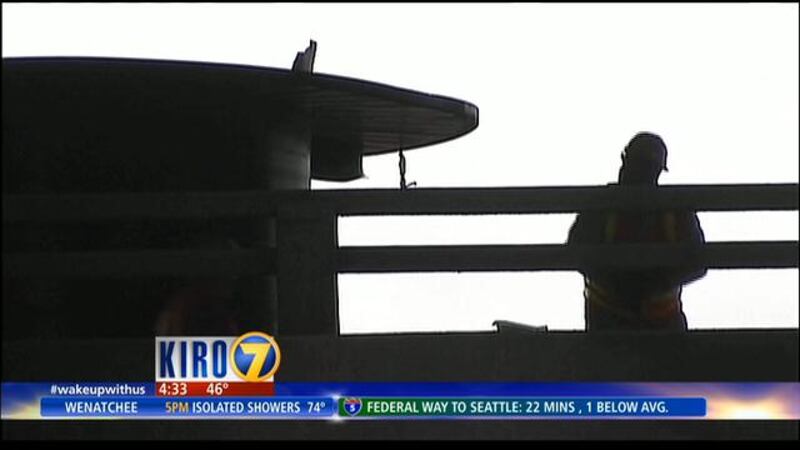SEATTLE — WSDOT officials inspected a southbound lane of the viaduct for any additional damage Wednesday night after a semi-truck lost its load: two giant metal spools.
Investigators said the driver of the truck didn't have the required permits for the oversized load.
The viaduct was closed overnight while inspectors checked for cracks and damage.
Small pieces of concrete came off when the truck's load hit part of the viaduct's upper deck, causing small pieces of concrete to come off.
"Anytime we have an overstrike hit or a traffic hit on a bridge, we follow it up with a close-up inspection and monitor it to collect data to have an ongoing record of what has happened," said state inspector Greg Seipel.
The inspection was completed about 2 a.m. The viaduct was deemed safe for drivers, and the highway was open for the Thursday morning commute.
Seipel said there was no significant damage.
The incident occurred near Seneca Street about noon Wednesday.
Brian Myers was in a truck behind the accident and saw smoke and dust. "It looked like he hit it pretty hard and people were able to get away," said Myers.
The two massive metal spools had just left Seattle Center and were en route to Alabama when at least one, and perhaps both, slammed into the bottom of the upper deck, too tall for the roadway. Witnesses reported that the chains that appeared to have been holding the spools in place broke, allowing both to tilt off the truck.
It was so loud, workers in the office building next to the viaduct thought it was an earthquake.
"When the truck impounded on the viaduct, the whole window shook. It was really loud," said Jason Hauschildt.
According to Midwest Specialized Transportation, the driver was Andy Perez, who has been with the company for more than 20 years.
He had no safety-related incidents until he drove without a City of Seattle permit for an oversized load on Wednesday.
He was cited $482 for failing to obtain the permit, violating his state permit by operating without a city permit, and causing damage to the viaduct.
SDOT is still trying to determine if a pilot vehicle was in front of the spool truck at the time of the accident.
Seattle police and Seattle Department of Transportation officials promised to improve the speed at which blocking accidents are cleared. On March 24, a semi loaded with fish blocked the southbound lanes of the viaduct for more than nine hours.
On Wednesday, crews worked quickly. The city brought in a state engineer to evaluate the best way to get the two large metal spools and the flatbed truck off the elevated structure. Workers used a front loader already near the scene to lift the spools back onto the flatbed. Seattle police used social media to warn drivers about the closure.
By 1:45 p.m., both spools were on the truck and authorities were working to make them secure.
The truck was on its way and the viaduct reopened shortly before 2 p.m.
Before the March 24 blocking incident, the city prioritized property above traffic. Now the city has put clearing traffic before property, so there was less concern about whether the spools were damaged.
"I think the protocols are pretty clear right now," said SDOT Director Scott Kubly. "Life, safety, then clearing for traffic, then property.”
SDOT said no one is monitoring the viaduct's camera on the Battery Street Tunnel all the time to ensure oversized loads stay off. Signs are posted for the 14-foot limit.
But around Seattle there are even stronger warnings to help warn people and prevent similar, costly mistakes.
The area around the Washington Park Arboretum has detectors and flashing lights to warn vehicles before an underpass.
Seattle Center has a loud alarm for vehicles above a certain height.
KIRO 7 asked SDOT about the possibility of additional warnings on the road.
Spokesperson Rick Sheridan said the viaduct is appropriately signed and added that drivers are obligated to watch for and obey the signs. They said if the driver had applied for a city permit, the city of Seattle would have advised him of another route.
Want to talk about the news of the day? Watch free streaming video on the KIRO 7 mobile app and iPad app, and join us here on Facebook.
KIRO








